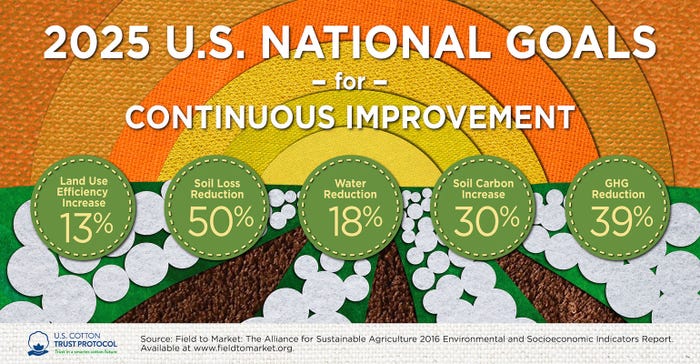July 15, 2020

Starting today (July 15), brands and retailers can join the U.S. Cotton Trust Protocol, a new system for responsibly grown cotton that will provide annual data for six areas of sustainability in line with the U.N. Sustainability Goals. This year-over-year data, available for the first time, will allow brands and retailers to better measure progress towards meeting sustainability commitments.
“One of our goals in developing the Trust Protocol is to give brands and retailers greater confidence when including U.S. cotton in their sourcing mix,” said Ken Burton, executive director of the U.S. Cotton Trust Protocol. “Participating brands and retailers will now be able to demonstrate measurable progress in reducing their environmental footprint and in achieving sustainability targets.”
The Trust Protocol underpins and verifies sustainability progress through sophisticated data collection and independent third-party verification. By working with Field to Market: The Alliance for Sustainable Agriculture and Control Union Certifications North America, the Trust Protocol enables brands and retailers to better track the cotton entering their supply chains. Brands that become members of the Trust Protocol will have access to aggregate year-over-year data on water use, greenhouse gas emissions, energy use, soil carbon and land use efficiency.
“At Levi Strauss & Co., the quality and sustainability of the cotton we use is critical to our business and important to our customers. We are deeply committed to sourcing sustainable cotton and reducing water usage, carbon emissions, and chemical usage,” said Liza Schillo, senior manager, Global Sustainability Integration, Levi Strauss & Co. and Trust Protocol Board Member. “We are, therefore, in strong support of the introduction of standards — including the U.S. Cotton Trust Protocol — that champion sustainably grown cotton and drive wider adoption over the long-term of sustainable cultivation practices.”
The Trust Protocol is a complement to existing sustainability programs and is designed from the ground up to fit the unique cotton mass-growing environment of the United States. “We are engaged in an open dialogue with existing standards in the cotton industry, and open to are exploring future collaboration," added Burton.
In June, the Trust Protocol was added to Textile Exchange’s list of 36 preferred fibers and materials that more than 170 participating brands and retailers can select from as part of Textile Exchange’s Material Change Index program.
35 years of continuous improvements
Over the past 35 years, U.S. cotton has made significant improvements in growing cotton responsibly.

To continue the progress, the Trust Protocol has ambitious national goals for 2025. By this date, the Trust Protocol aims to have more than half of all U.S. cotton production included in the program.

“Achieving a transition towards agricultural sustainability requires broad public and private partnerships and a vital part of my work at The Nature Conservancy includes looking at ways to collaborate with key agricultural stakeholders,” said Dr. Kris Johnson, Deputy Director of Agriculture, The Nature Conservancy, North American Region and U.S. Cotton Trust Protocol Board Member. “Informed by science-based targets, the Trust Protocol provides evidence of and encourages continuous improvements in U.S. cotton production.”
Source: National Cotton Council, which is solely responsible for the information provided and is wholly owned by the source. Informa Business Media and all its subsidiaries are not responsible for any of the content contained in this information asset.
You May Also Like




